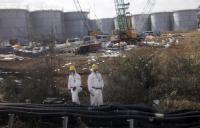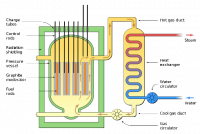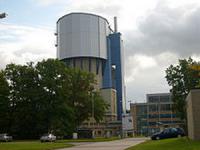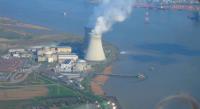-
NRC asked to shut down Indian Point nuclear plant

Located twenty-six miles from New York City, in the right weather conditions a radiation release at Indian Point nuclear power plant could reach Times Square in as little as ninety minutes, making evacuation of New York City impossible and rendering the area uninhabitable for a long time. Critics of the agiing plant say that the disappearance and disintegration of more than 1 in 4 critical bolts holding the Indian Point nuclear reactor cooling system together is far more serious than owner, Entergy, admits.
-
-
Fukushima’s lesson: Better real-time monitoring of spent fuel pools is a must

The 2011 Fukushima Daiichi nuclear accident should serve as a wake-up call to nuclear plant operators and regulators on the critical importance of measuring, maintaining, and restoring cooling in spent fuel pools during severe accidents and terrorist attacks, says a new report from the National Academies of Sciences, Engineering, and Medicine.
-
-
Decommissioning Fukushima: Mapping boron distribution in molten debris
Decommissioning the Fukushima Daiichi Nuclear Plant just got one step closer. Japanese researchers have mapped the distribution of boron compounds in a model control rod, paving the way for determining re-criticality risk within the reactor.
-
-
Turbulent mixing research makes advanced thermal reactors safer

Researchers are working to make advanced thermal reactors safer by establishing trusted uncertainty guidelines regarding advanced reactor turbulent mixing processes. “The overall goal of this project is the efficient management of heat transfer and being able to predict what’s going to happen in accident scenarios from a thermal hydraulics standpoint,” one researcher said. “A lot of what I’m doing in this research is focused on establishing uncertainty in the predictive tools that we have for measuring those accident scenarios.”
-
-
What we learned from Chernobyl about how radiation affects our bodies
The world has never seen a nuclear accident as severe as the one that unfolded when a reactor exploded in Chernobyl on 26 April 1986, sending vast amounts of radiation into the skies around Ukraine, Belarus and Russia. The planet had experienced massive releases like this before, in the bombings of Hiroshima and Nagasaki in 1945. But Chernobyl-related radiation exposure had a more protracted character. It was the first time in history that such a large population, particularly at a very young age, was exposed to radioactive isotopes, namely iodine-131 and cesium-137, not just through direct exposure, but through eating contaminated food as well.
-
-
More money for nuclear safety pledged on Chernobyl 30th anniversary
The EU and other global donors have pledged an additional $99 million to help secure the Chernobyl power plant, as ceremonies in the Ukraine mark thirty years since the disaster. The money will be used to construct a new spent nuclear waste storage facility, adding to the €2 billion already donated to helping clean up and secure the Chernobyl site. A new giant $1.7 billion steel structure will be placed over the nuclear reactor this year to prevent further radioactive leaks. The old concrete structure was put together after the meltdown, but experts say it is not leak-proof and that, in any event, it is beginning to show its age.
-
-
The legacy of Chernobyl -- 30 years on
The 26 April 2016 marks the 30th anniversary of the Chernobyl nuclear accident. For many, especially those born since 1986, it is a word they know without appreciating the full significance of what happened on that day. For others, it was a life changing catastrophe which resulted in largest release of radioactivity in the history of nuclear energy.
-
-
Dealing with irradiated nuclear graphite

Since the beginning of the nuclear power industry, a large number of channel uranium-graphite nuclear power reactors was built across the world. To date, they all are on the output stage of the operation or decommissioning preparation. Approximately 250,000 tons of irradiated graphite are accumulated in the world, including ~ 60,000 tons in Russia. Due to the specificity of irradiated graphite, the treatment of this type of radioactive waste has not been determined yet.
-
-
Forget Fukushima: Chernobyl still holds record as worst nuclear accident for public health
The 1986 Chernobyl and 2011 Fukushima nuclear power plant accidents both share the notorious distinction of attaining the highest accident rating on the International Atomic Energy Agency (IAEA) scale of nuclear accidents. No other reactor incident has ever received this Level 7 “major accident” designation in the history of nuclear power. But the IAEA scale isn’t designed to measure public health impact. Chernobyl is by far the worst nuclear power plant accident of all time. It was a totally human-made event which was made worse by incompetent workers who did all the wrong things when attempting to avert a meltdown. Fukushima in contrast, was an unfortunate natural disaster – caused by a tsunami that flooded reactor basements — and the workers acted responsibly to mitigate the damage despite loss of electrical power. In terms of health ramifications, these two nuclear accidents were not even in the same league. While Fukushima involved radioactivity exposures to hundreds of thousands of people, Chernobyl exposed hundreds of millions. And millions of those received substantially more exposure than the people of Fukushima.
-
-
Belgium turns down Germany’s request to shutter two aging Belgian nuclear plants
Belgium on Wednesday turned down a request by Germany to shut down two ageing nuclear power near the German-Belgium border. Belgium said the two plants, while old, still meet the strictest safety standards. Both the Doel and Tihange power stations, in operation since 1974, were scheduled to be shut down and decommissioned in 2015.
-
-
Paris attacks' mastermind had files on German nuclear waste facility

Salah Abdeslam, the mastermind of the November 2015 terrorist attacks who is now in custody in Belgium, had in his possession documents about a nuclear research center in Germany. The Juelich nuclear center near the Belgium-Germany border is used for the storage of nuclear waste.
-
-
Digital mapping project tracks the last moments of the victims of Japan’s 2011 tsunami
Digital archives track the evacuation patterns of 2011 Great East Japan Earthquake victims between the time the earthquake and tsunami struck. The Tokyo Metropolitan University researchers who created the digital archives say they will make use of the archive to analyze evacuation behaviors — encouraging people, for instance, to avoid overestimating evacuation sites and head to higher ground.
-
-
Is Belgium’s nuclear security up to scratch?
Belgium’s counter-terrorism efforts are once again being called into question following the recent tragedies in Brussels. The attacks were carried out against soft targets – the public check-in area of Brussels Airport and Maelbeek metro station – but a series of unusual and suspicious occurrences were also reported at nuclear facilities in the country. These events highlight the very real threat to nuclear facilities. For Belgium, this recent episode is one item on a long list of security concerns. Based on this history, the Belgian authorities should be primed to take nuclear security especially seriously. But there are serious questions about whether they are.
-
-
U.K. to ship highly enriched uranium for disposal in U.S.

The United Kingdom will ship large quantities of enriched uranium for disposal in the United States, and in return will receive nuclear material from the United States for use in the treatment of cancer patients in Europe. About 700kg of radioactive waste, most of which is held at Dounreay in northern Scotland, will be shipped to the United States to be treated in American nuclear disposal plants, which have a greater capacity than British plants to dispose of radioactive materials.
-
-
Brussels attackers originally planned to attack a nuclear facility: Belgian authorities

The terrorists who attacked the airport and a metro station on Tuesday had originally considered targeting a Belgian nuclear site, but that such an attack would have required more time and planning. The terrorists abandoned the nuclear facility attack plan after Belgian security services arrested a number of Islamist militants, forcing the terrorists to act more quickly and focus on soft targets instead of a hardened nuclear facility. EU counterterrorism coordinator said that Belgium’s network of nuclear power stations could become the targets of cyberattacks by terrorists in the near future. “And if [ISIS] ever did turn to nuclear weapons,” one experts says, “they have more people, more money and more territory under their control and more ability to recruit experts globally than Al Qaeda at its best ever had.”
-
More headlines
The long view
Smaller Nuclear Reactors Spark Renewed Interest in a Once-Shunned Energy Source
In the past two years, half the states have taken action to promote nuclear power, from creating nuclear task forces to integrating nuclear into long-term energy plans.
Keeping the Lights on with Nuclear Waste: Radiochemistry Transforms Nuclear Waste into Strategic Materials
How UNLV radiochemistry is pioneering the future of energy in the Southwest by salvaging strategic materials from nuclear dumps –and making it safe.
Model Predicts Long-Term Effects of Nuclear Waste on Underground Disposal Systems
The simulations matched results from an underground lab experiment in Switzerland, suggesting modeling could be used to validate the safety of nuclear disposal sites.
